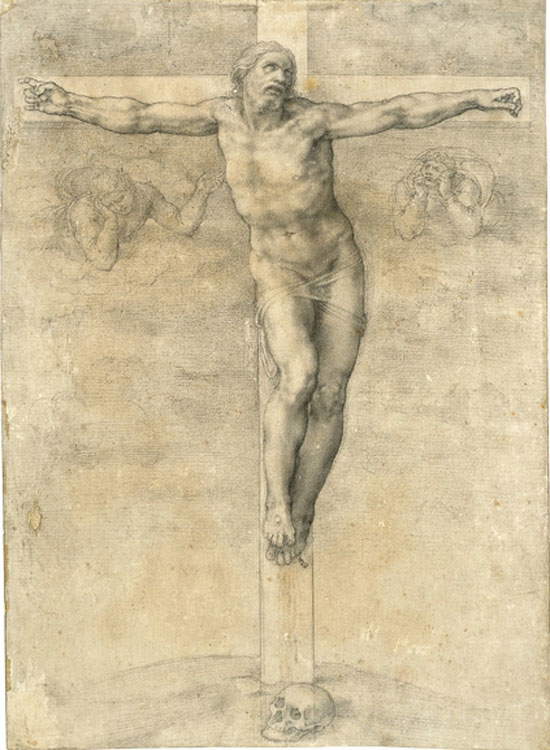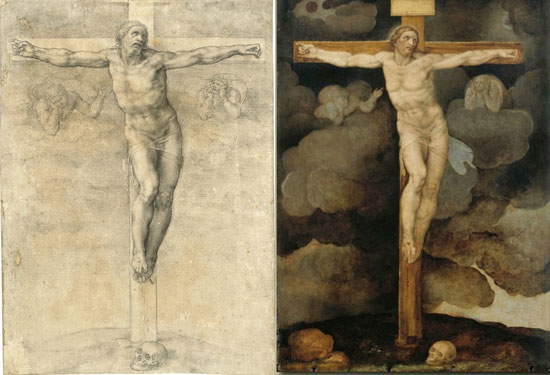The press office of the El Greco exhibition in Treviso had announced in the last few hours that a new discovery would be presented to the public today: certainly, few imagined that among the others there would be a discovery that, if confirmed, would be of enormous significance. Professor Lionello Puppi has in fact announced that he has found the famous Crucifixion executed by Michelangelo Buonarroti for Vittoria Colonna: a work that until now was thought to be lost and that was known only through a charcoal drawing on paper kept at the British Museum in London, and through copies made by other artists.
Lionello Puppi, a well-known specialist in Venetian art (but who has also worked on Michelangelo), tracked down the painting in a private collection and, as we learn from the Mattino di Padova, considers it stylistically compatible with the British Museum drawing. From the photos so far circulated on the web, not much can be guessed: we publish, below, an image circulated by Art Post Blog, which was present at this morning’s press conference, and a further image proposed by Mattino di Padova. From these first images, the painting (which seems unfinished, however) does not seem to have the same quality as the drawing: the modeling seems coarser, the relief given by the chiaroscuro in the drawing is practically absent in the painting, and the poses of the angels on the sides appear less natural. We repeat, however, that the quality of the diffused images does not allow us to make a proper judgment. Now we will have to wait for the debate, which of course will open, and the opinions of the scientific community to understand whether we are dealing with a real discovery, which if confirmed could really be the most interesting and sensational in recent years, or whether the painting discovered by Lionello Puppi is nothing but a copy. However, the work will remain on display at the El Greco exhibition: so for those who want to see it, the appointment is in Treviso.
Update (6:15 p.m.). We received, just as we were publishing the article, a statement from the press office of the “El Greco in Italy” exhibition containing the reasons that would lead Lionello Puppi to attribute the painting to Michelangelo. We reproduce the text following the images below.
 |
| Michelangelo, Crucifixion for Vittoria Colonna (c. 1538-1541; 36.8 x 26.8 cm; London, British Museum |
 |
| The painting discovered by Lionello Puppi in the image circulated by Art Post Blog |
 |
| The painting discovered by Lionello Puppi in the image disseminated by Mattino di Padova |
 |
| Drawing and painting compared |
The dellinedita pictura thesis of the Crucifixion that sees it attributable to Michelangelo
"Io lho ben visto al lume et col vetro et col specchio et non vidi mai la più finita cosa " (Vittoria Colonna)
The Christ on the Cross panel is a new work in the exhibition placed in the Crucifixion room. Tradition conveys to us an El Greco who did not like Michelangelo Buonarroti, however, it cannot be denied that he took him as a reference and model in his artistic productions, especially regarding precisely liconography of the crucifix. Christ on the cross could be depicted in two manners: either as Christus patiens, thus a suffering Christ, with his head reclined downward, or as Christus vigilans, alive, with an erect head and open eyes or, even, Christus triumphans, with regal attributes, expressing sovereignty over the living and the dead.
Michelangelo Buonarroti is the first to propose a Christus vigilans. El Greco, who initially painted a type of suffering Christ, patiens, only after his landing in Spain followed Michelangelo’s revolutionary liconography, and the Crucifix dated post-1590 and from Auckland Castle can be seen in the exhibition to testify to this.
Regarding the Christ on the Cross, attributable according to Prof. Lionello Puppi to Michelangelo Buonarroti, the cues to support the thesis are:
The author of this article: Federico Giannini e Ilaria Baratta
Gli articoli firmati Finestre sull'Arte sono scritti a quattro mani da Federico Giannini e Ilaria Baratta. Insieme abbiamo fondato Finestre sull'Arte nel 2009. Clicca qui per scoprire chi siamoWarning: the translation into English of the original Italian article was created using automatic tools. We undertake to review all articles, but we do not guarantee the total absence of inaccuracies in the translation due to the program. You can find the original by clicking on the ITA button. If you find any mistake,please contact us.